by Carol Roberts
Discus are sold under a confusing variety of names. What are the different types of discus and how do we tell them apart?
All colors and types of discus will interbreed and produce fertile fry. Some types like Pigeon Blood and Blue Diamonds are easily recognized. In this article I want to show you how discus can be placed in different categories and illustrate the types of discus available to hobbyists today.
How are discus different from each other and how are they alike? Discus are either classed as wilds, which means they were born in the Amazon region of South America, or as tank-bred domestics. Next we look at the physical characteristics. Underneath the color, underneath the pattern discus will either have or not have vertical bars. In a spawn of discus the vertical stress bars are the very first trait you are able to distinguish. Several weeks latter pattern will begin to develop and finally the color will fill in.
Let’s start with wilds. All wilds have vertical bars overlaid with varying amount of pattern or striations. Wilds are traditionally broken down into four classes.

Class 1 Heckle (Symphysodon heckel)
Heckles are different from other Discus in that three of the nine vertical bars are more prominent – the one through the eye, the fifth or middle bar and the caudal or tail bar.
Class 2 Brown (Symphysodon aequifasciata axelrodi)
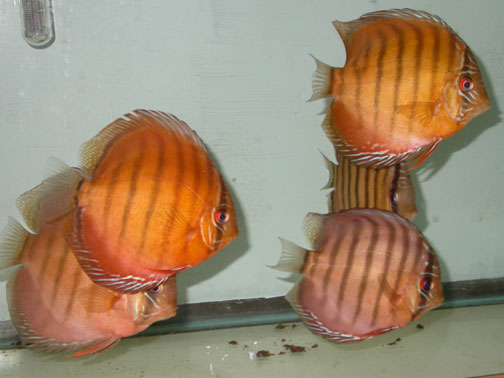
Class 3 Blue (Symphysodon aequifasciata haraldi)
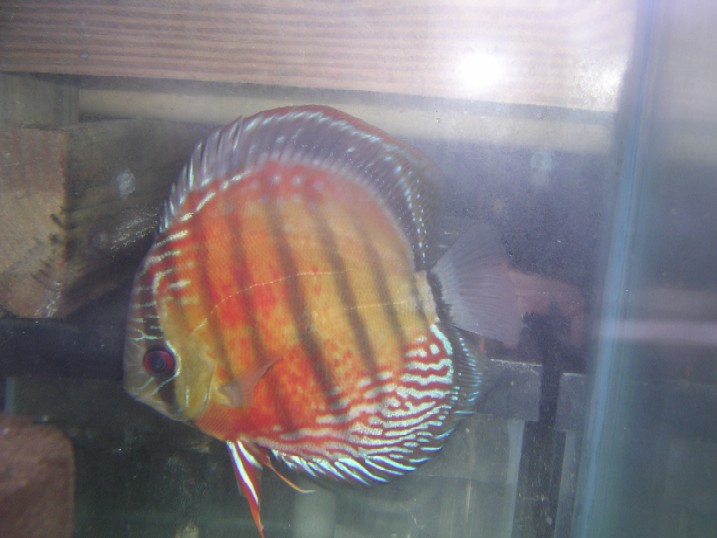
Class 4 Green (Symphysodon aequifasciata aequifasciata)
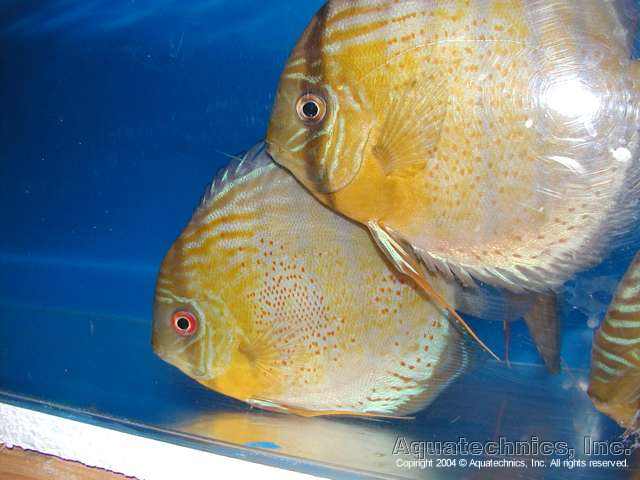
Wild Red Spotted Greens have a greenish-tan base color. The red spots are highly prized. Collectors look for discus with spotting over a large percentage of the body.
Domestic Red Spotted Green Discus
Wild Red Spotted Green discus have been selectively bred with domestic strains to produce spotted fish like this one.

Domestic discus are classified by physical appearance such as color and markings.
Class 5
Thick Line
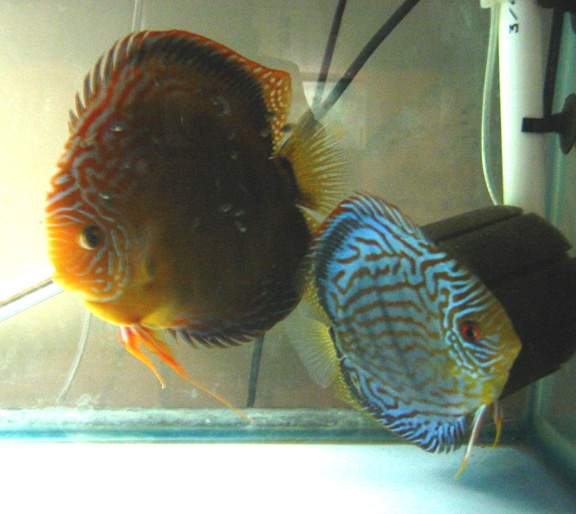
The first domestic discus were similar in appearance to wild discus. They had vertical stress bars with an
overlay of horizontal striations.
Striations can be classed as thick line or thin line. Turquoise Discus are one of many discus varieties with straight, thick striations.
Class 6
Thin Line
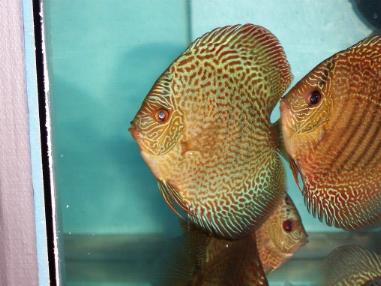
Snakeskin discus have a fine pattern of lines or striations. Most have 14 vertical bars. These discus have a distinctive pattern of fine lines and dots on their gill plates
Class 7
Pattern
This class would include Discus with complicated striations such as this Ring Leopard. Checkerboard and pearl are other common discus patterns
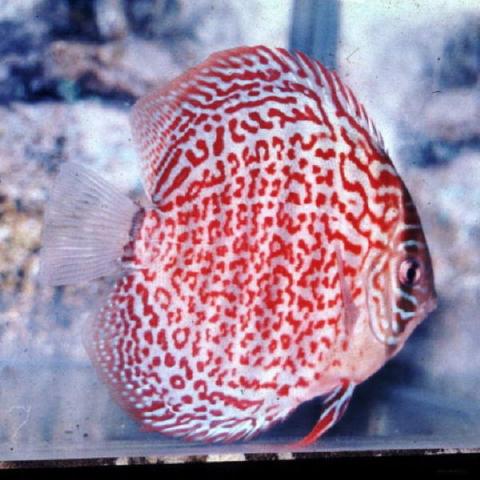
Class 8
Spotted
Discus with spots such as Red Leopards, domestic Red Spotted Greens and leopard spotted snakeskin would fit in this category.
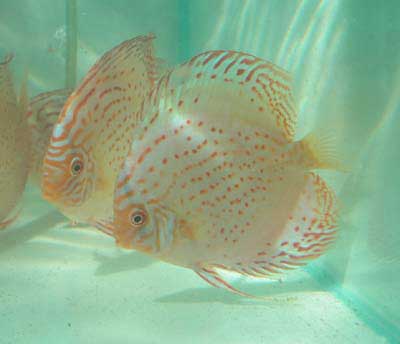

Class 9
Open Pattern
(Any pattern such as Albino Spotted, Albino Snakeskin, Golden Leopard Snakeskin etc.)
Another way to divide domestic discus is by color. Discus are commonly divided into color classes at shows.
Class 10 Blue (Blue Diamond, Cobalt, etc.)
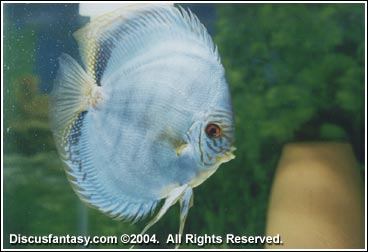
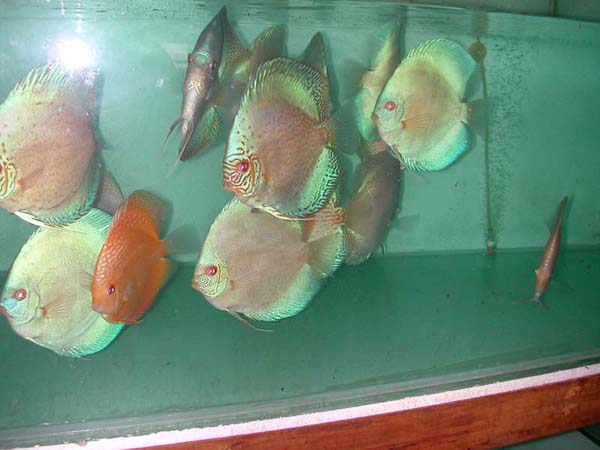
Class 11 Red (any red discus)
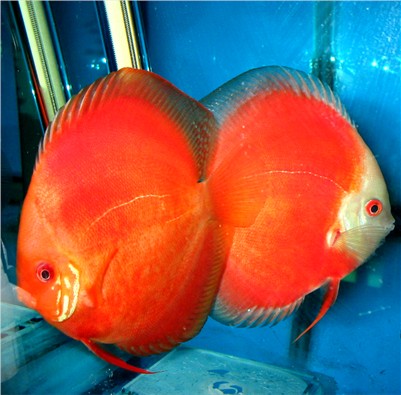
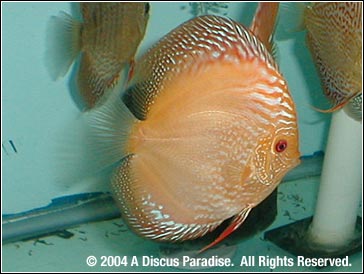
Class 12 Yellow (Pigeon Blood, Golden, Yellow Crystal, Golden Spotted)
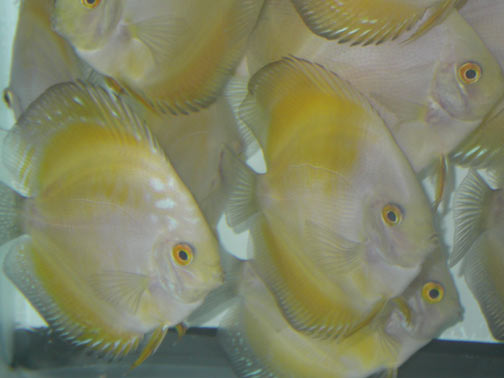
Class 13 White (Any white discus) Snow White

(White pigeon blood)
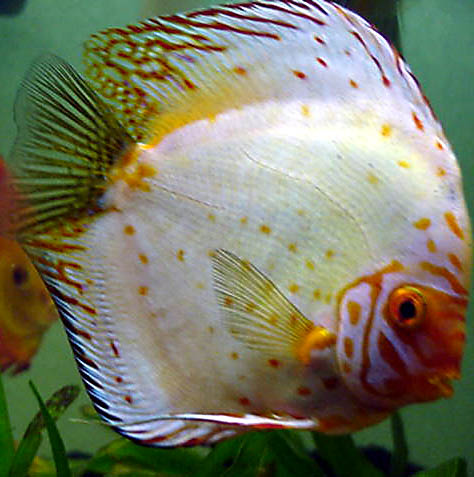
Class 14 Open (Yellow White, Red White, Calico, Ghost)

(Red/White)
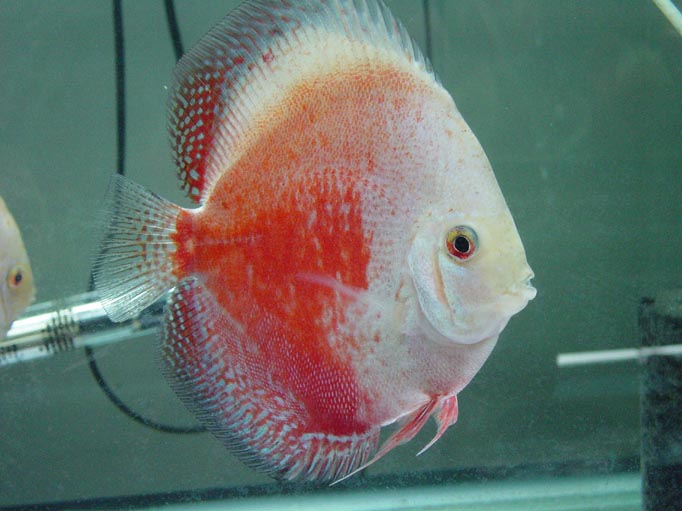
(Calico)
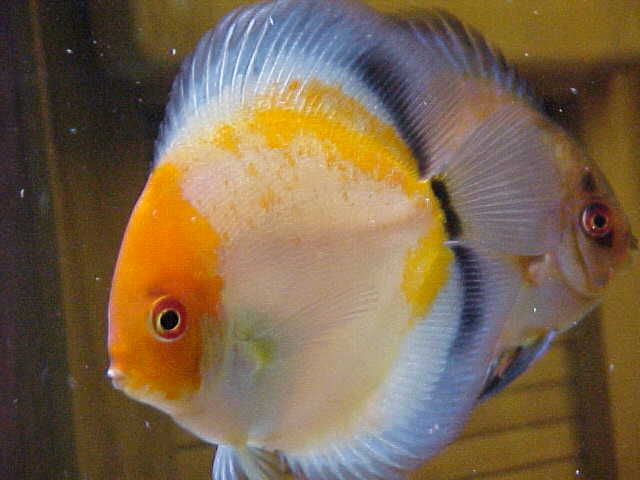
(Ghost)
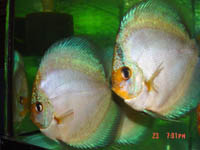
Since any discus can and will breed with any other discus it is sometimes hard to determine which class the resultant progeny belongs in. At discus shows it is up to the owner to decide the class best suited for his entry.
The discus pictured below are easy to distinguish and are popular in the hobby.

Turquoise Discus have vertical stress bars and a pattern of thick striations. The striations may be red or blue on a tan background. This is one of the oldest strains of domestic discus and can be found most anywhere discus are sold.
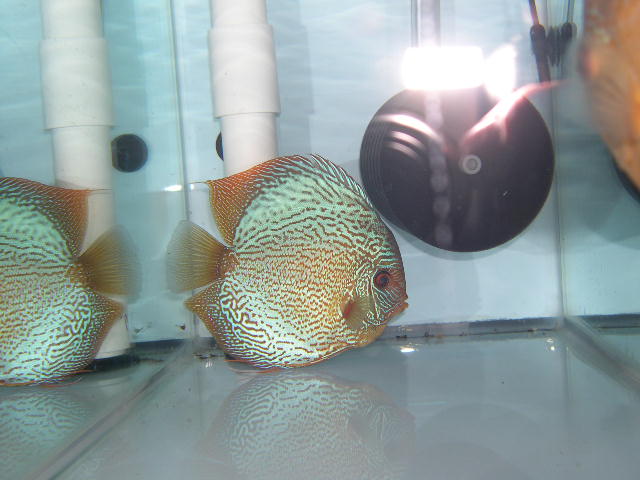
Snake Skins have vertical stress bars and a pattern of thin striations. The striations may be red or blue on a tan background. If you look closely you will notice a pattern of fine lines and dots on the gill plates that is unique to this variety of discus. Snakeskins have been successfully used in many crosses. You can find Leopard Snakeskins, Pigeon Snakeskins. Blue Diamond Snakeskins and even Red Spotted Golden Leopard Snakeskins.
Red Leopard Snake Skins

Red Leopard Discus
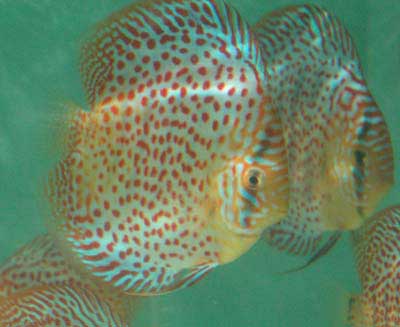
Red Leopard and Red Leopard Snake Skins have vertical stress bars and a pattern of thin or thick striations that are broken into small spots. The spots are red on a blue or tan background. Leopard Snake Skins will have a pattern of fine lines and dots on the gill plates.
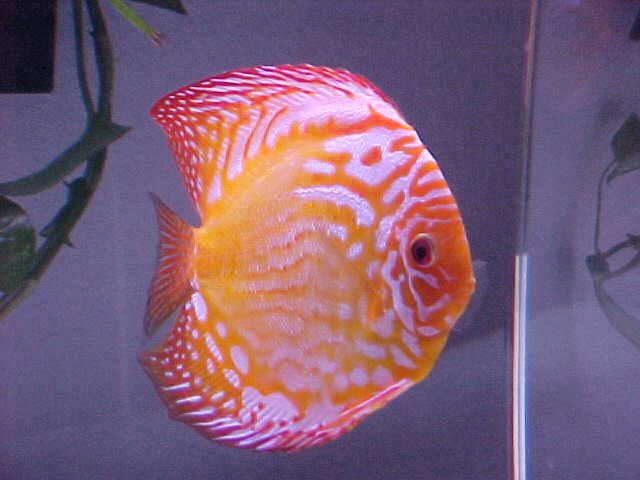
Pigeon bloods lack vertical stress bars and range in color from nearly solid white through yellow, orange, to a deep orangey red. They can be almost solid in color, striated with thick lines, thin lines, pearled or anything in between. Many are being bred with an overlay of red spots on the body. Pepper is a characteristic shared by all pigeon based discus. These small, black specks of pigment usually appear on the nose and face and are more prominent when the discus is stressed or ill. The newer strains of pigeons are being bred with less pepper. The pigeon blood gene is dominant. A Pure pigeon bred to any other discus will produce all pigeon fry. If the breeding is to a discus with vertical stress bars the fry may be heavily peppered. Pigeon based discus are sold under many names such as Marlboro, Melon, Tangerine, White Butterfly, Blue Panda and Golden.
Blue Diamonds lack vertical stress bars and are solid blue in color. There should be no striations on the face or fins. Red eyes are desirable. The Blue Diamond gene is recessive. Two blue diamonds bred together will produce all blue diamond fry.
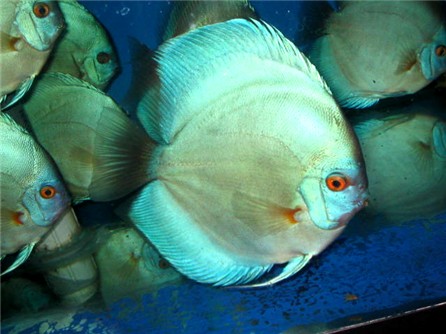
White Discus such as Snow Whites lack vertical stress bars and are solid white in color. The face may be more yellowish-white and the fins may show iridescent blue. There should be no striations on the face or fins. They have distinctive white eyes.
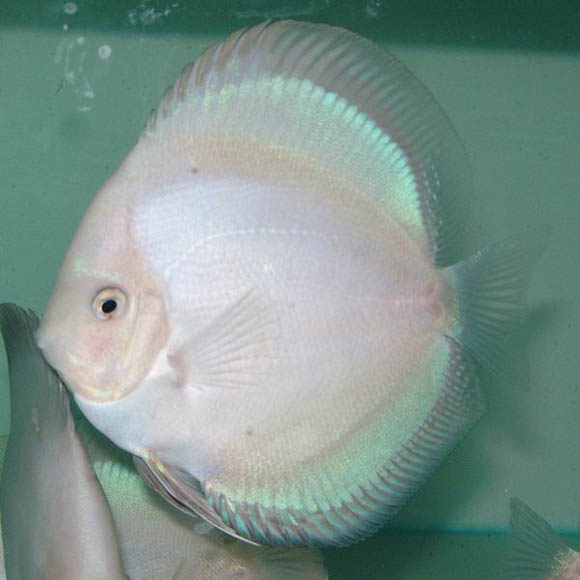
There are no hard and fast rules on classification. Many of the newer colors have been around less than 10 years and are not fixed. The buying public is fickle, tiring of the colors they already have and always on the look out for something new. Breeders are still experimenting with all manner of crosses in hopes of creating the next new color or pattern. Look at all that’s been accomplished in the last few years.
1988—Ghost Discus, a mutation of the brown is discovered.
1990/91—Golden Discus, another mutation from the brown.
1990/91—A nine bar snakeskin is imported from Thailand.
1992—Blue Diamond & Ocean Green become popular
1993—14 bar snakeskin discovered in Penang is thought to have inherited the characteristic from wild discus.
1995—Snakeskin strains are exported.
1995—Leopard skin is developed from selected Red Diamonds.
1997—White Discus are much improved
1998—Red/White & Yellow/ White are introduced.
2000—San Merah & Red Melon are imported to improve the strain.
2000—Backcrossing snakeskin strains introduces many different variants.
The above timeline is from an article by Joe Szelesi posted on the Brooklyn Aquarium Society website. Here is a link to the full article. http://www.brooklynaquariumsociety.org/Articles/2002-sept-pg%2029.htm
Red Spotted Golden

Discus Names can be confusing. It’s not always easy to guess the genetic make-up of a particular discus by it’s name or by looking at it. Briefly here are common characteristics that can help you determine the background of your discus.
Snake Skins are one of the most popular crosses right now. Look for thin lines (striations) with a distinctive pattern of fine lines and dots on the gill plates. Many will have 14 vertical stress bars. Eyes are red or amber.
Ghosts do not have vertical stress bars on the body, but may have partial bars on the eye and tail, will have predominately white eyes (may have some red pigment) with black pupils.
White based discus have no vertical stress bars, will have dominant white eyes (may have some red pigment) with black pupils.
Albino Discus lack pigment, so they will not exhibit vertical stress bars and will have pink eyes.
Pigeon Bloods do not have solid vertical stress bars, can be just about any pattern or color (usually orange) and have fine black speckles called pepper on the face and elsewhere. Eyes will be amber or red. They are dominant and first generation crosses will all look like pigeons.
Blue Diamonds do not have vertical stress bars and no pattern on the fins or face. Eyes will be amber or red. Two Blue Diamonds will produce all Blue Diamond fry.
Discus with similar genetic make-up can have very different sales names. Look for stress bars, pattern, body color, pepper and eye color to determine type of discus.
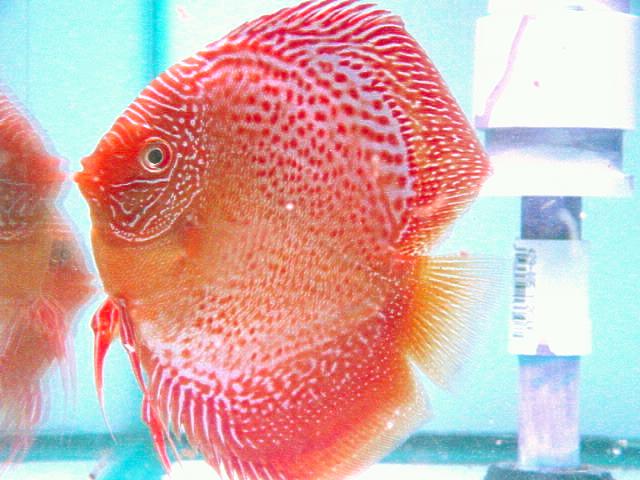
Red Leopard Snakeskin


THE BEST DISCUS COLOR STUDY THAT I HAVE SAW. CONGRATULATION
A very well done discus classification of the various varieties available today. Great job:) congratz!
Can you lisT any books on this subject?
Get Best Knowledge About Discus Fish Varities
Thank You Friends
Discus Fish Lover From INDIA
Ashish Samanta
This is a perfect article. I love how descriptive it is and all the pictures. Whenever I’m looking for an article on coloration there aren’t always pictures showing what they’re describing. I must say this was very clear and well put together. Perfect thank you. I never leave comments but felt the need to now.
Extremely informative and precise information
Does anyone know where I can buy a poster of the different Discus types.I have seen a poster on Pinterest ,but am unable to find it at the retail level. Thanks for your help.
Not right of hand, sorry.
GOOD INFORMATION regarding DISCUS FISH but is there any clascification of blood group